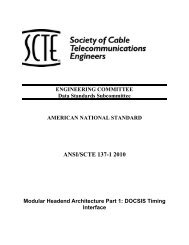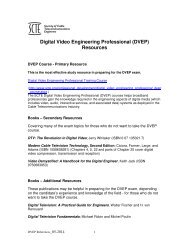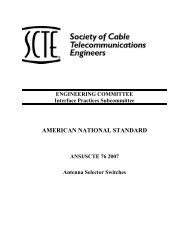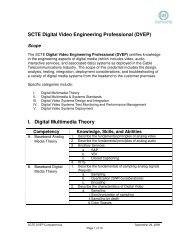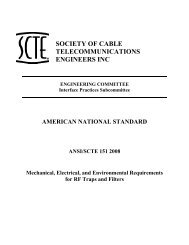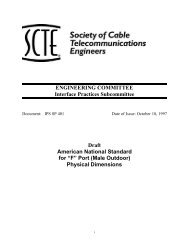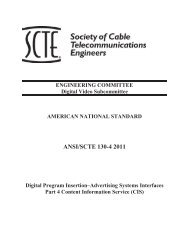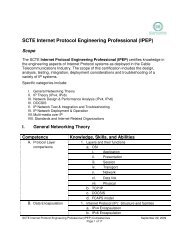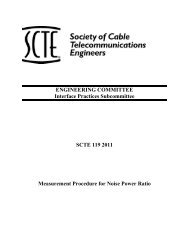SCTE IPS Template, Rev 2
SCTE IPS Template, Rev 2
SCTE IPS Template, Rev 2
- No tags were found...
Create successful ePaper yourself
Turn your PDF publications into a flip-book with our unique Google optimized e-Paper software.
The second assumption is that the non-linearity of the device is ‘incremental’, meaning that thedistortions are a fraction of the energy (i.e. < 40 dB) below the channel carrier amplitudes. (Thispurposely is not precise; it only illustrates the magnitude of ‘incremental’.) The output responsewill then be considered adequately described by the first three terms of the Volterra expansion(i.e. only the second and third order non-linearities, in addition to the linear response, will beconsidered).The third assumption is that the input waveform should not produce very large peak signallevels. (Again this is not precise, but is important to understand that the formulated resultdepends upon the convergence of the series expansion.) Note that this third assumption isclosely related to the second assumption, but is used for a different purpose. It will allow us toformulate a ‘closed-form’ solution without specific details of all of the system’s transferfunctions.As described previously, the higher order transfer functions of the non-linear system (withmemory) are dependent on more than one frequency component. We will greatly simplify theproblem by considering these transfer functions to be ‘single-frequency dependent’, which is ourfourth assumption. Computationally, this means that the multivariate (i.e. multi-dimensional)transfer functions described by equation {A.8} are then considered to be ‘single-variable’functions, where the variable is the sum of the input frequency components, instead of beingdependent upon each and every individual frequency component. The physical implication is,that all the distortion products being of the same type and being composed of input signals thathave the same amplitude levels, would then have the same distortion levels for the samedistortion frequency, regardless of the frequencies of the comprising (input) signals. (Or, anypair of third-order distortion products that occur at the same frequency will have the samemagnitude of distortion no matter what two, or three, different fundamental frequencies of theinput signal they are comprised from.) Note that, distortion products of the same type, located atdifferent (sum and difference) frequencies, could have different levels. The terms of equation{A.8} would then involve only one-dimensional convolutions. In addition, the non-linearsubsystems of the equation can be regarded as composed of ‘zero-memory’ networks, while thelinear term would then be ‘time-invariant’. (This would be the case if the junction capacitancewere constant.)Each term in the output response then, is a form of the input response modified by the magnitudeand phase of the particular transfer function. As in the case of frequency dependent linearsystems, the great advantage of single-frequency dependent non-linear systems is, the secondand the third order harmonic levels alone can characterize them.Typically, the linear gain of a wide-band device is flat, within the band of interest. Many widebanddevices will also exhibit transfer characteristics that have measurable third order distortionlevels that are approximately equal, when the sum of frequencies of the comprising signals isapproximately equal. This is especially true of wide-band devices whose operation is closelyapproximated by ‘unilateral’ operation, or the ‘feedback’ of the device has no appreciable (closeloop)phase. Applying these assumptions allows a formulation for the problem at hand. A18



